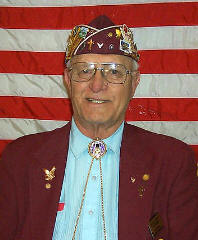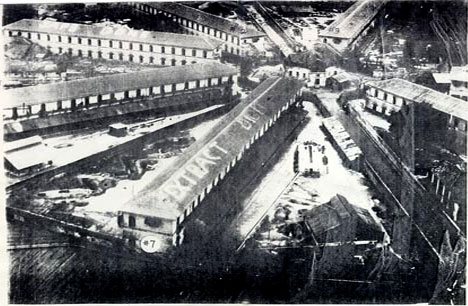
Established April 14, 1942
 |
American Ex-Prisoners of War
A not-for-profit, Congressionally-chartered veterans’ service organization advocating for former prisoners of war and their families.
Established April 14, 1942 |


Francis E. Sawyer
|

The living quarters of Francis Saywer.'s camp
|
|
| Last Name | First Name, Middle Init. | Nickname |
| Street Add. | City | State |
| Zip | Spouse | |
| Conflict | Branch of Service | Unit: |
| Theatre of Operation | Military Job | Where Captured |
| Date Captured | Time Interned | Camps |
| Date Liberated | Medals Received | Age at Capture |
| After the War ... | ||
Five men from their crew were lost. They were Omar Austin, Robert Witte, George Marshall, Frank Chiarello and Frank Peters. Their untimely deaths were due to the inability to escape or fright. Thpse who did escape were very lucky and told themselves they were not going to bend to the enemy. They never did.
After spending two nights at Maubin and getting more of what they received at Pantanau they started down the river again to Rangoon. That afternoon they reached the city they had bombed a few days previously. They arrived by boat, not by plane as in the past. The boat was tied to one of the docks they used to bomb. They had made a mess of it.
They were removed from the boat and taken to a jail close to the docks. It was in this jail they learned to lie. The five of them made up a story and they held to it.
They knew they had to stick to these stories, as they would be questioned separately. When each man would return after a questioning period they would compare notes so that they would not make it hard for anyone. It was hard to keep from being tripped up by the Japanese interrogators. They were questioned all five of the days they were at this jail.
One day Francis was told to draw a map of his base. He showed signs of hesitation but after being kicked a few times he decided to comply. On the paper they had given him was a sketch of the base with everything in the wrong places such as the gasoline storage area at the end of the runway. Nothing was correct. When Francis finished he gave the paper to the interrogator and crossed his fingers. He looked at the map, turned and called to someone in the next room. A man came into the room and the interrogator gave him the drawing and told him to check it. This was an Indian who had turned traitor and joined the Japanese.
After checking the drawing he gave it back and said it looked correct to him although it had been some time since he had been on the base. Francis was still safe. Their stories had worked thus far.
They were a bit on the hungry side when they left the jail. Everything was mixed together like swill and was on the salty side. They hadn't eaten much in the past five days. After they had spent those five days in that jail they were transferred to their "permanent home": The Rangoon Central Jail, the prison they had flown over on raids to Rangoon. This prison had been a civilian prison until the English abandoned it.
Francis had only 35 missions but he was satisfied. Thirty-five missions do not look like many missions to some people, but his missions were logged differently from in Europe. His missions were from 5 to 14 hours in length. His were logged by the hours and not by the number of missions as in the European Theater.